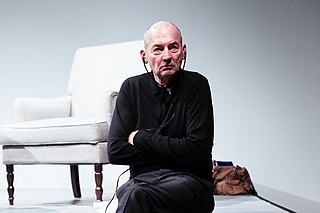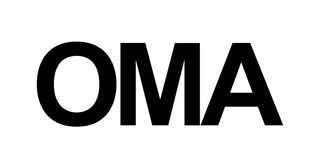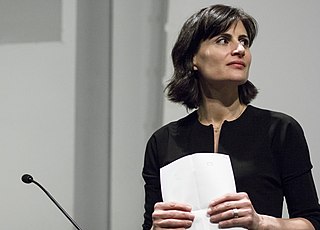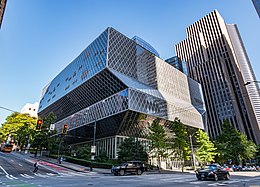
Remment Lucas Koolhaas is a Dutch architect, architectural theorist, urbanist and Professor in Practice of Architecture and Urban Design at the Graduate School of Design at Harvard University. He is often cited as a representative of Deconstructivism and is the author of Delirious New York: A Retroactive Manifesto for Manhattan.
The year 2004 in architecture involved some significant architectural events and new buildings.

The Seattle Public Library (SPL) is the public library system serving the city of Seattle, Washington. Efforts to start a Seattle library had commenced as early as 1868, with the system eventually being established by the city in 1890. The system currently comprises 27 branches, most of which are named after the neighborhoods in which they are located. The Seattle Public Library also includes Mobile Services and the Central Library, which was designed by Rem Koolhaas and opened in 2004. The Seattle Public Library also founded the Washington Talking Book & Braille Library (WTBBL), which it administered until July 2008.

The Office for Metropolitan Architecture (OMA) is an international architectural firm with offices in Rotterdam, New York, Hong Kong, Doha, and Australia. The firm is currently led by eight partners - Rem Koolhaas, Reinier de Graaf, Ellen van Loon, Shohei Shigematsu, Iyad Alsaka, Chris van Duijn, Jason Long, and managing partner and architect David Gianotten.
The year 2005 in architecture involved some significant architectural events and new buildings.

The CCTV Headquarters is a 51-floor skyscraper formed out of a pair of conjoined towers that sits on the East Third Ring Road, Guanghua Road in the Beijing Central Business District (CBD) and serves as the headquarters for China Central Television (CCTV). Rem Koolhaas and Ole Scheeren of OMA were the architects in charge for the building, while Cecil Balmond at Arup provided the complex engineering design. The building is among the world's largest office buildings.

The Embassy of the Netherlands in Berlin is the Netherlands's diplomatic mission in Berlin, Germany. Designed by Rem Koolhaas of OMA, the building was opened in 2004.

Erez Ella, is an Israeli architect.

Cecil Balmond OBE is a British Sri Lankan designer, artist, and writer. In 1968, Balmond joined Ove Arup & Partners, leading him to become deputy chairman. In 2000, he founded design and research group, the AGU . He currently holds the Paul Philippe Cret Chair at PennDesign as Professor of Architecture where he is also the founding director of the Non Linear Systems Organization, a material and structural research unit. He has also been Kenzo Tange Visiting Design Critic at Harvard Graduate School of Architecture (2000), Eero Saarinen Visiting Professor at Yale University School of Architecture (1997-2002) and visiting fellow at London School of Economics Urban Cities Programme (2002-2004).

The Leeum, Samsung Museum of Art is a museum in Hannam-dong, Yongsan District, Seoul, South Korea. It is run by the Samsung Foundation of Culture. It is considered one of South Korea's top three private art museums.
REX is an architecture and design firm based in New York City. The firm's name is intended to symbolize reappraisal ("RE") of architecture ("X"). Notable projects headed by its founder include the Dee and Charles Wyly Theatre in Dallas, Texas; the Vakko Fashion Center in Istanbul, Turkey; and the Seattle Central Library. The work of REX has been recognized with accolades including two American Institute of Architects' National Honor Awards in 2005 and 2011, a U.S. Institute for Theatre Technology National Honor Award, an American Library Association National Building Award, and two American Council of Engineering Companies' National Gold Awards.
The World Architecture Survey was conducted in 2010 by Vanity Fair, to determine the most important works of contemporary architecture. 52 leading architects, teachers, and critics, including several Pritzker Prize winners and deans of major architecture schools were asked for their opinion.
LMN is an American architecture firm based in Seattle, Washington. The company was founded in 1979, and provides planning and design services to create convention centers, cultural arts venues, higher education facilities, commercial and mixed-use developments.
The year 2011 in architecture involved some significant architectural events and new buildings.

Fernando Romero Havaux is a Mexican businessman, design curator, and architect. He is the founder of fr·ee and Archivo Diseño y Arquitectura. He is the son-in-law of Mexican billionaire, Carlos Slim.
The year 2020 in architecture involved some significant architectural events and new buildings.

Amale Andraos is a New York-based architect. She was dean of the Columbia Graduate School of Architecture, Planning and Preservation (2014-2021) and serves as advisor to the Columbia Climate School. She is the co-founder of the New York City architecture firm WORKac with her husband, Dan Wood. Her impact on architectural practice around the world was recognized when she was named Honorary Fellow of the Royal Architectural Institute of Canada in 2021.

The Calgary Central Library, also known as the Calgary New Central Library (NCL), is a public library in Calgary, Alberta, Canada, and the flagship branch of the Calgary Public Library system. The building is located in the Downtown East Village neighbourhood and opened on November 1, 2018, replacing an earlier central branch built in the 1960s in Downtown Calgary.

121 East 22nd is a building in the Gramercy Park neighborhood of Manhattan in New York City. Developed by American company Toll Brothers, it is the first building in New York City designed by Rem Koolhaas's architectural firm OMA.

Delirious New York: A Retroactive Manifesto for Manhattan is a 1978 book, written by Dutch architect Rem Koolhaas. The book serves as a retroactive manifesto for Manhattan between 1850 and 1960, analyzing the development of architecture and urban design throughout New York's history from the founding of New Amsterdam by the Dutch, to the design of the Headquarters of the United Nations by Le Corbusier. Rem Koolhaas describes the concept of 'Manhattanism', the theory of the creation and functioning of the city of New York, at length in the book.






























